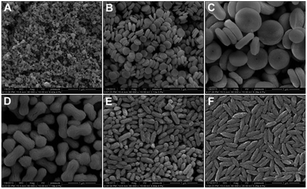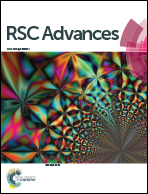Generalized green synthesis of diverse LnF3–Ag hybrid architectures and their shape-dependent SERS performances†
Abstract
This paper reports the generalized green synthesis of a series of LnF3–Ag (Ln = Nd, Sm, Eu, Tb) hybrid architectures with tunable shape, surface features, and composition. These intriguing hybrid structures are formed through the uniform magnetron sputtering of silver (Ag) nanoparticles on LnF3 micro-supporters. The LnF3–Ag surfaces are corrugated with high-density and numerous Ag nanogaps (which can serve as Raman active ‘hot spots’, to amplify the Raman signal), providing the sound reliability and reproducibility of Raman detection. We find that the special spindle structure of TbF3–Ag particles display the highest Raman enhancement efficiency compared to disk-, pancake-, peanut-, and rice-like structures. These experimental observations are in good agreement with the theoretical calculation by using the three-dimensional finite difference time domain (3D-FDTD) method. It is found that the produced LnF3–Ag composites are robust and efficient SERS substrates for high sensitivity detection of molecular adsorbates. Raman results show that the limit of detection (LOD) for crystal violet (CV), p-aminothiophenol (PATP) and Rhodamine 6G (R6G) of the optimized TbF3–Ag spindles substrate are as low as 10−11 M, 10−10 M and 10−14 M, respectively, which meets the requirements for ultratrace detection of analytes. In addition, the LnF3–Ag substrates are stable and can be produced with high reproducibility, which shows great potential applications for universal SERS substrates in practical SERS detection.


 Please wait while we load your content...
Please wait while we load your content...